| Basic Specifications | |
|---|---|
| Full model name: | Canon EOS R3 |
| Resolution: | 24.10 Megapixels |
| Sensor size: | 35mm (36.0mm x 24.0mm) |
| Kit Lens: | n/a |
| Viewfinder: | EVF / LCD |
| Native ISO: | 100 - 102,400 |
| Extended ISO: | 50 - 204,800 |
| Shutter: | 1/8000 - 30 sec |
| Dimensions: | 5.9 x 5.6 x 3.4 in. (150 x 143 x 87 mm) |
| Weight: | 35.8 oz (1,015 g) includes batteries |
| MSRP: | $5,999 |
| Availability: | 11/2021 |
| Manufacturer: | Canon |
| Full specs: | Canon R3 specifications |
Canon EOS R3 Preview -- First Impressions
by William Brawley
At long last, after being teased a couple of times with a pair of development announcements, the full details of Canon's upcoming EOS R3 professional mirrorless camera are here! The upcoming R3 will be Canon's fifth full-frame R-series mirrorless camera and will sit above the EOS R5 as Canon's most high-performance, high-end R-series camera to date. However, despite its high-tier status among Canon's camera lineup, the company states that it's not technically their "flagship" camera. The 1D X Mark III (or the 1D X-series in general) reigns supreme as Canon's top-tier EOS camera for now. The new EOS R3, therefore, sits between the R5 and the 1D X series, but it will still serve as the top-of-the-line R-series camera.
The Canon EOS R3 features an all-new body design for an R-series mirrorless camera -- though despite the 1D X-like design -- the R3 is much lighter than its DSLR sibling. The camera also features an array of new features and technologies, including an all-new 24MP stacked CMOS BSI sensor, impressive 30fps burst shooting, updated Dual Pixel CMOS II AF with more sophisticated subject tracking capabilities, Eye Control AF, internal 6K 60p RAW video recording, IBIS and much more!
Read on for all the details on Canon's news top-of-the-line R-series mirrorless camera!
Canon EOS R3 Key Features & Specs
- All-new Canon-developed, full-frame 24.1MP stacked BSI CMOS sensor
- DIGIC X Image Processor
- ISO 100-102400 (Expandable: Low ISO 50 to High ISO 204800)
- Up to 30fps burst shooting with electronic shutter; 12fps with mech. shutter
- Dual Pixel CMOS AF with Deep Learning-based eye- and body-detection AF
- New recognizable subjects with Subject-detection AF (Vehicle Subject Recognition for cars and motorcycles)
- Low-light AF down to -7.5EV
- IBIS with up to 8 stops of combined IS (Optical + IBIS)
- 6K 60p RAW video, 4K 120p 10-bit with Canon Log 3
- New body design with integrated vertical grip & 1D X-level weather-sealing
- New 5.76M-dot OLED EVF with "Eye Control AF" functionality
- Fully articulated touchscreen LCD
- Built-in Wired LAN and 5GHz Wi-Fi
- Flash supported with electronic shutter
- Dual Memory Cards: 1 CFExpress , 1 UHS-II SD
- $5999 MSRP
Design & Ergonomics: Canon brings gripped design & 1D-class weather-sealing to mirrorless R-series
As you can see from the product images, the new Canon EOS R3 features a large, one-piece design with an integrated vertical grip, much like Canon's 1D-series DSLRs. This should make the ergonomics much more balanced and comfortable when shooting with longer, heavier lenses and when shooting in portrait orientation. However, despite the larger body design, the EOS R3 manages to be much lighter in weight than a 1DX Mark III, for example, making it much for comfortable and easier to carry and use for long periods of time. A 1DX III with battery tips the scales a bit over three pounds (~1440g), while the new R3 shaves off some weight to come in at about 2.2 pounds (~1015g). The overall size, too, is a bit more svelte than a modern 1D-series camera, with the R3 measuring up at about 5.91 inches (150mm) wide, 5.61 inches (142.6mm) tall and 3.43 inches (87.2mm) deep.
In terms of durability and build quality, the EOS R3 body is constructed from a lightweight, one-piece magnesium alloy chassis and is also said to offer the same robust level of dust- and moisture-resistance as Canon's flagship 1D X-class cameras, despite the significant reduction to overall weight. All ports, doors, buttons and dials, are sealed to the same degree as on a 1D X Mark III, ensuring durability and reliability in adverse weather conditions and the ability to withstand the general wear and tear that a professional photographer's gear may face in the field.
Across the face of the camera, the R3 features several front-facing buttons, similar to what is offered on an EOS 1D-series camera. These buttons, much like most of dials and buttons, can been extensively customized depending on user preference and shooting situations. Further, the vertical grip position offers its own shutter release button and front command dial.
We now finally have a full view of the top deck of the EOS R3. As you can see above, it looks very similar to the EOS R5 in a lot of ways off to the right of the viewfinder, with the R3 featuring a similarly-sized square info display panel, a Mode button in the center of the rear thumb control dial (for changing exposure modes), a front control dial, a customizable M.Fn button and info panel lamp button. Unlike the R5, there is no dedicated video recording button on the top of the camera -- instead, this is located on the back of the camera, much like it is on a 1DX III. Interestingly, the R3 does not feature a trio of quick-access buttons for white balance or ISO, as seen on 1D-series cameras. There is a dedicated Exposure Compensation button, as we're used to seeing. Presumably, the user can customize other buttons on the camera to offer one-touch access to White Balance and ISO settings; or more likely, the R3 behaves like other R-series cameras -- such as the R5 -- with one of the three control sub-dial defaulting to instant ISO adjustment, for example.
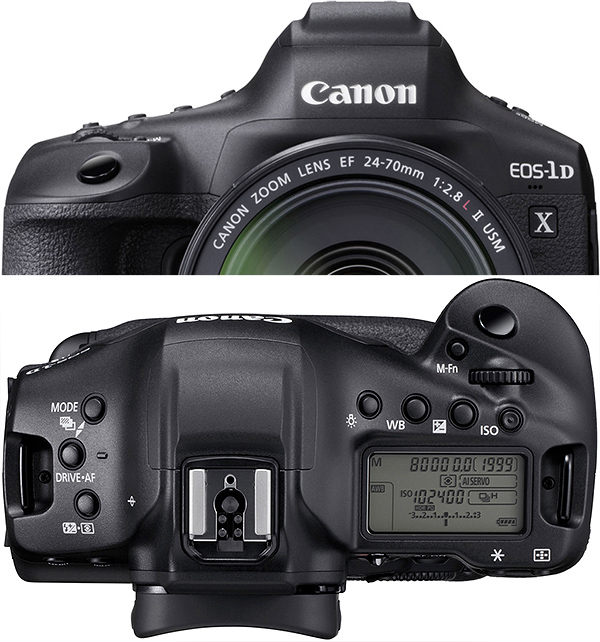 |
On the left of the EVF, we see a difference in buttons compared to the R5/R6 cameras; there's no on/off switch on the top of the R3 like we see on Canon's other R-series models. Similar to a 1D-series camera, the power switch is located on the back of the camera (along with a "lock" setting to prevent any unwanted button or control presses). We have a pair of buttons off to the left of the EVF, which is similar to what we find on a 1D-series body. There is a button to enable Drive Mode settings and AF modes, and another for Flash Exposure Compensation and Metering Mode settings. Pressing these two buttons at the same time will bring up Auto Exposure Bracketing settings.
Moving to the rear of the camera, the R3 features a design and control layout that's not all that dissimilar to that of a 1D-series camera. The R3 does, however, lack the secondary sub-display screen on the back, like EOS 1D-series models traditionally have. There are touch-sensitive Smart Controller buttons (AF-ON) and multi-directional joysticks in both horizontal and vertical orientations. One major design change compared to a 1D-series camera is the addition of an articulated rear LCD. Much like an EOS R5, for example, the EOS R3 features a fully-articulated 3.2-inch LCD touchscreen that swings out to the side and can even face forwards. One notable upgrade to the LCD screen over that of the R5 and 1DX III is a nearly 2x increase in resolution, with the R3 featuring an LCD panel with nearly 4.15-million dots of resolution -- up from the 2.1M-dot screen on the R5 and 1D X III.
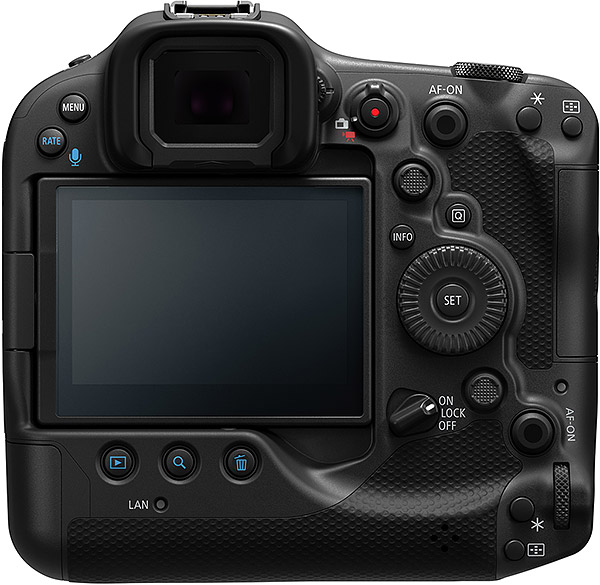 |
The large, bright electronic viewfinder on the R3 is also worth pointing out in detail. Looking just at the specs, the EVF appears to be largely the same as the one from the R5 -- a high-resolution 5.76-million-dot OLED with 60fps and 120fps refresh rates and a 0.76x magnification factor. However, Canon is quick to point out that this is, in fact, a different EVF, newly designed for the R3 and not the same one inside the R5. The OLED panel itself is all-new and is actually designed by Canon themselves. The EVF is designed and built to look like you're looking through a 1DX's optical viewfinder, thanks to its natural field of view and OVF Simulation function. The responsive high-res EVF offers reduced lag time and is said to suppress a decrease in refresh rate even while shooting in continuous mode (compared to the R5). The aforementioned OVF Simulation feature utilizes Canon's HDR technology and the EVF's high brightness to display a more natural view of your scene, with more natural-looking highlight and shadow detail. Using the OVF Simulation view assist mode also turns off the typical live exposure simulation behavior of an EVF, giving you a more familiar experience to using an optical viewfinder.
Ports, Battery and Connectivity
The Canon R3 features a range of networking functionality designed for news media and other professional workflows, including built-in 5GHz Wi-Fi connectivity, browser-based remote control functionality, wired LAN with FTPS/SFTP/HTTPS, voice memo and more. The overall connectivity and networking functionality of the R3 is very similar to that of the 1D X Mark III. However, Canon is also debuting a new mobile app called Mobile File Transmitter alongside the EOS R3. Unlike a 1D X III, the R3 does not feature a connection for a WFT Transmitter accessory; that accessory's wired LAN functionality is now built into the R3 itself and operated via the Mobile File Transmitter app. Using the new mobile app, users can send photos directly to a remote server or cloud service, manage IPTC metadata, add voice memos to files and more. The R3 also supports a direct wired connection to an iPhone, allowing for a stable mobile device connection; the app/phone then provides wireless communication for the camera, such as a 5G/LTE connection. (So far, the iPhone wired connection using a Canon Smartphone Holder K490 optional accessory is supported on the EOS R3 only.0
The camera also sports dual card slots in the form of one CFExpress card slot and one SD. The camera also includes a new hot-shoe, the Multi-Function Shoe, that supports data communication and power, as well as supporting new accessories, including a new digital shotgun microphone. Speedlite functionality will also be possible when using the camera's electronic shutter.
For power, the R3 uses the same LP-E19 battery back as the 1D X Mark III, and features a CIPA-rated battery life of around 620 shots per charge with the viewfinder in Power Saving mode (440 in "Smooth" mode) or around 860 shots/charge with the LCD in Power Saving mode (760 in "Smooth" mode).
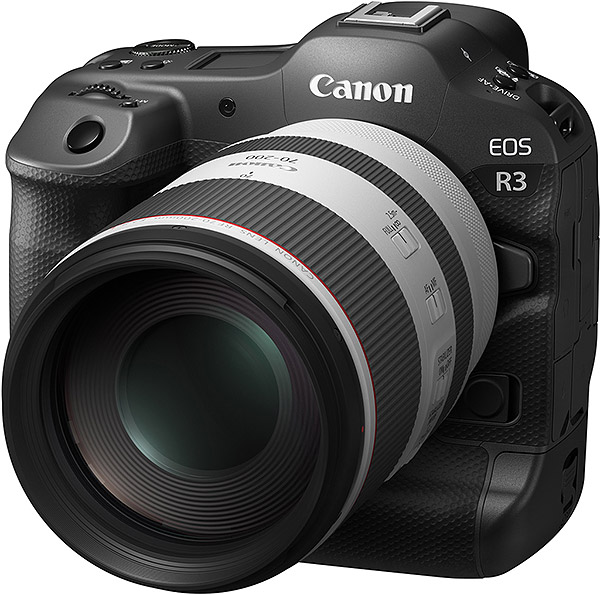 |
Imaging Pipeline: All-new full-frame 24MP Stacked BSI CMOS sensor is designed for speed
From a broad overview, the new EOS R3, much like the 1DX-series, is designed for professionals and advanced amateurs and, in particular, those needing a durable and high-speed camera with fast burst shooting and sophisticated AF performance for photojournalism, sports, wildlife and other action subjects. The EOS R3 is, therefore, centered around an all-new, Canon-developed full-frame sensor, designed for high-speed readout performance and minimal rolling shutter distortion when using the electronic shutter.
Unlike a camera such as the EOS R5, which is more heavily focused on image resolution with its 45MP sensor, the EOS R3, on the other hand, is all about speed and performance over sheer megapixel count. As such, the EOS R3 -- much like the 1DX-series -- features a lower-resolution image sensor. In the case of the R3 specifically, the camera utilizes an all-new Canon-made 24.1-megapixel full-frame sensor. The image sensor is also Canon's first stacked full-frame CMOS sensor with a back-illuminated structure. Despite the slightly lower 24MP resolution, Canon states that the R3 image quality is above the 30MP 5D Mark IV. In other words, Canon states that the R3 can achieve higher resolving power than the technically higher-resolution 5D IV sensor. Canon states that this is possible due to the quality of the sensor itself and the accompanying image processing; it's more than just sheer megapixel count when it comes to actual image resolution performance. (When we were first told of this characteristic, we wondered if perhaps the R3's sensor lacked an optical low-pass filter, unlike the 5D Mark IV's sensor with a fixed OLPF. However, we now see in the specs that the EOS R3 does, in fact, still utilize an optical low-pass filter. It will be interesting to compare side-by-side how the R3's image quality stacks up against the 5D Mark IV, and also other higher-resolution cameras.)
Additionally, the R3's stacked sensor design, in a similar vein to the stacked CMOS chips inside the Sony A9-series and the Sony Alpha 1, allows for faster data readout from the sensor, which in turn helps reduce "rolling shutter" distortion during fast electronic shutter-based still-image shooting as well as offer blackout free behavior during continuous burst shooting. Canon claims very minimal rolling shutter distortion during still-image shooting compared to other Canon cameras' electronic shutters thanks to the sensor's fast readout and the DIGIC X's fast image processing. Furthermore, the R3's high-speed sensor will provide an electronic shutter with continuous burst shooting rates of up to 30fps with continuous AF and auto-exposure, as well as 14-bit RAW recording with the electronic shutter.
In electronic shutter mode, the R3 offers a blackout-free experience in the viewfinder. Images are never interrupted by the "shutter" function, making it easier to continuously track moving subjects. As mentioned, the electronic shutter allows for up to 30fps continuous burst shooting with full-time AF and AE. Switching over to mechanical shutter, the R3 offers up to 12fps continuous shooting -- and, of course, a blackout in the EVF when firing off images.
The back-illuminated design of the new sensor also allows for better light-gathering efficiency compared to traditional front-illuminated sensor designs. Paired with a DIGIC X image processor -- the same processor from the 1D X III and R5/R6 cameras -- the new EOS R3 offers a wide ISO range spanning a native ISO 100-102,400. The ISO sensitivity can be further expanded down to a low ISO 50 equivalent and up to an extended high ISO 204,800.
When using the mechanical shutter, the EOS R3's shutter speed ranges from 30s to a typical 1/8000s. However, switching to electronic shutter mode, the camera is capable of some impressively quick shutter speeds, going all the way to 1/64000 seconds. Note: In electronic shutter mode, shutter speeds of 1/10000 sec. or faster are only available in Tv or M mode (while shutter speeds are capped at up to 1/8000 sec. in Fv, P, or Av modes).
In terms of buffer capacity, the R3 is, as you might expect, pretty beefy. Buffer capacity varies depending on shutter type, as they have different maximum continuous shooting rates, as well as memory card type. With the faster 30fps of the electronic shutter mode, the R3's RAW (and RAW+JPEG or RAW+HEIF) buffer capacity is stated to be about 150 frames, regardless of card type.
Using the slower 12fps mechanical shutter will give you essentially an unlimited buffer capacity with a CFexpress card ("1000 or higher" according to the specs) -- using a UHS-II SD card here, however, is vastly different with a buffer capacity listed as just 290 frames.
Switching to the compressed C-RAW file type or just a JPEG or HEIF image will, as expected, increase the buffer capacity significantly, with most options in the 30fps burst mode going over the 500 frames mark.
The Canon R3 also offers improved auto white balance performance thanks to a deep-learning-based system based on image sensor data. Previously, with Canon EOS DSLRs, the metering sensor was utilized to help distinguish between grass, trees and lawns. However, now, the R3 is the first EOS camera to make use of image sensor data with deep-learning algorithms to better detect these elements within a scene and thus render more natural-looking greenery, such as grass and trees.
Further, the in-camera system for setting a custom white balance has been improved. The camera now lets you quickly and easily manually set a white balance value from a Live View image. Using the "Record and Set WB" option in the custom WB menu, you can then shoot and register a WB value right from Live View.
IBIS: Same in-body image stabilization as the EOS R5 & R6
Much like the EOS R5 and R6, the new EOS R3 features in-body image stabilization, and the camera, in fact, uses the same IBIS mechanism as these earlier EOS R-series cameras. The R3, therefore, offers essentially the same level of stabilization performance, with the 5-axis IBIS system rated for up 8 stops of correction depending on the lens used.
Autofocus: High-speed Dual Pixel CMOS AF II and Eye Control AF technology
Given the emphasis on speed and performance for sports and wildlife, it comes as no surprise that the Canon EOS R3's autofocus system is designed for top-notch performance, both in terms of focus acquisition speed but also precision and subject-tracking performance. Canon states that the R3's AF system is built upon the sophisticated and upgraded Dual Pixel CMOS AF II system we saw in the EOS R5 and EOS R6 cameras. The R3's AF system incorporates Deep Learning for its subject-detection system that will track eyes and bodies as well as birds and certain types of animals.
The EOS R3's autofocus coverage essentially spans the entire surface area of the sensor. While the number of individually selectable AF points wasn't specified, the R3 offers a maximum total of 1053 AF zones (in a 39 x 27 grid) in stills mode, similar to the number of AF zones on the R6. That camera, meanwhile, offers up to 6,072 user-selectable AF points, so we suspect a similar amount here on the R3. (For video, the R3 offers up to 819 AF zones in a 39 x 21 array.) Additionally, the EOS R3's AF system is said to be able to focus in extremely low light conditions, down to -7.5EV (the Canon R5 is rated down to -6EV, by comparison).
One of the significant areas of focus, no pun intended, is the camera's AF speed and tracking performance. The R3 is capable of AF calculations and tracking with up to 60fps when using the electronic shutter. The camera's improved EOS iTR AF X (Intelligent Tracking & Recognition) can now detect and acquire the subjects just by getting the AF point close to the target, and the camera features additional deep-learning-based subjects that the camera's AF system can automatically detect and track.
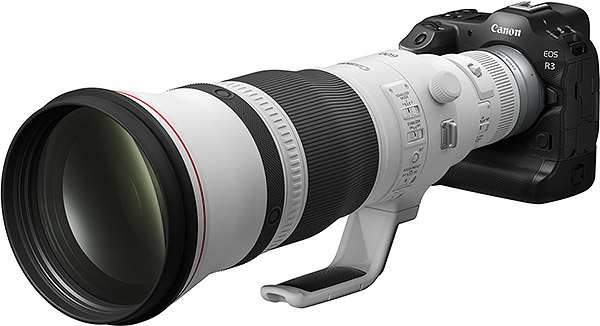 |
The EOS R5 featured intelligent subject detection of both human and animal eyes/face/body (animal: dogs, cats and birds). According to Canon, the R3 offers the same level of subject-detection performance as the R5 when it comes to animal AF detection and tracking, while People-detection AF has been improved with updated Body Detection for when subjects are moving quickly and the AF system is unable to detect a face or head. Further, Eye-Detection has been improved for more difficult-to-capture scenarios, such as when a subject is turned to the side (profile), has eye makeup, the eye(s) are in shade, or when the subject is wearing a mask. Head detection has also been tweaked to account for winter sports scenarios where a subject's face is obscured with large goggles and masks while skiing/snowboarding.
Beyond people- and animal-tracking, the R3 now includes -- for the first time in a Canon EOS camera -- motor vehicle subject recognition and tracking, including cars and motorcycles. Designed most specifically for motorsports photography scenarios, the camera's AF system can be set to detect and track several types of fast-moving vehicles, including Formula cars, GT cars, rally cars, as well as on- and off-road motorcycles. When photographic open-cockpit race cars, such as those in Formula 1 as well as motorcyclists, the AF system is capable of detecting the helmet of the driver.
In terms of AF operability, the EOS R3 now offers Subject Tracking AF in any AF Area mode; user can toggle Subject Tracking on or off regardless of what AF point mode they are using. Even the Spot Single Point AF mode can now utilize Subject Tracking. In total, Spot, Single-point, Expand AF area, Expand AF area (Surround), Flexible Zone and "Entire Area AF" (full AF area) modes can all utilize the camera's subject tracking AF. With subject tracking enabled, AF operation will start wherever the user has positioned the AF point(s), and will then continue to tracking the subject across the frame and moving the AF point as required.
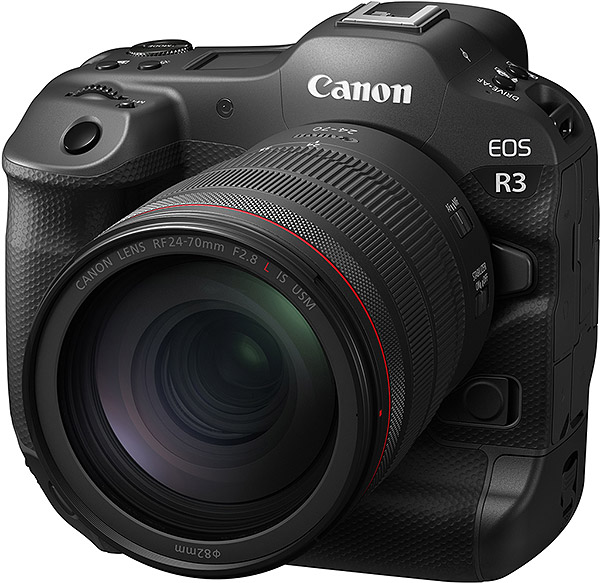 |
Eye Control AF
One very cool new feature that's making its debut (or "re-debut," rather) for the first time in a modern EOS digital camera: Eye Control AF. Incorporated into the R3's EVF, the R3 will let users select the initial AF point or area for AF subject tracking simply by looking at a particular area in the frame. The EVF's Eye Control AF system will track a user's eye as they look through the viewfinder and then quickly move the AF point/area to the spot where they are looking upon half-pressing the shutter button (or AF button). In theory, this should make it much quicker to reposition the AF point in fast-moving scenarios than fiddling with a rear joystick control or directional buttons.
I mentioned "re-debut" as this isn't the first time a Canon camera has had this type of eye-tracking-based AF control. Several Canon EOS film cameras, starting with the EOS A2E in 1992, included an Eye Control AF feature, offering the same general idea as in the R3: move the focus point to where the user's eye is looking. Having never used a Canon film camera with Eye Control AF, I can't comment on how well it worked. However, from this interesting retrospective on the technology from Dale Baskin at DPReview, performance seemed like a bit of a mixed bag depending on which camera you used; the EOS 3 camera with a 45-point AF system appeared to struggle a bit more with picking the precise AF point than the Elan II E did with its modest 3-point AF system.
Canon does state that there are some limitations to the EOS R3's Eye Control AF. Eye input AF might not be available in specific shooting environments or when wearing certain sunglasses, mirror sunglasses, hard contact lenses or bifocal eyeglasses. The Canon film cameras' implementation did allow for some degree of calibration of the Eye Control system to account for eyeglasses or contact lenses, and according to Canon, an Eye Calibration is necessary to properly use Eye Control AF on the R3. The camera includes a step-by-step guide in the menus on calibrating Eye Control AF, and the user can have different calibration profiles depending on the situation (i.e. one calibration profile for no eyeglasses, one with glasses, one with contact lenses, etc.). Canon also states that calibrations can, and perhaps should be done multiple times, as the camera's Eye Control AF precision improves with additional calibration processes.
Additional Shooting & User Features
The EOS R3 offers several new features for flash photography, including support for using flash with both mechanical and electronic shutter -- the first EOS camera to support flash in electronic shutter mode. You can shoot with flash up to 1/180s shutter speed with electronic shutter and at up to 15fps.
The R3 also has some clever anti-flicker features to help capture clean, evenly exposed images under certain lighting conditions. On the R5 and R6, anti-flicker mode was only available in mechanical shutter mode, but with the R3, it's now possible with electronic shutter as well. With normal fluorescent/mercury lamps, the camera can be set to suppress flicker at 100Hz/120Hz frequencies. The R3 can shoot at up to 24fps with electronic shutter in the 120Hz anti-flicker mode. Additionally, the R3 allows for shutter speed fine-tuning for high-frequency flicker seen with faster-flickering LED lighting. The camera offers both an automatic or manual option to bias shutter speeds by the decimal value (i.e. 1/100.1, 100.2, etc). In manual mode, you can use Live View to see the banding or flickering effect and then dial in a more precise shutter speed until the banding or flicker does not appear.
For photojournalists or others working in sound-sensitive environments, the EOS R3 offers a dedicated Silent shooting mode. This is different than just switching to Electronic Shutter mode; in Silent mode, other operational sounds as well as AF assist lights are disabled to make shooting completely quiet and as distraction-free as possible. In normal Electronic Shutter mode, the camera produces a simulated shutter actuation sound; it's possible in Silent Mode to use headphones to hear the shutter sound without disturbing others around you.
Video
While the Canon R3 is arguably a stills-oriented camera, this new high-end mirrorless camera is no slouch when it comes to video recording features. The camera includes internal 6K RAW video recording, 4K up to 120p, Canon Log 3, 10-bit recording and is designed for sustained recording times with no 29:59 recording limits.
With 6K RAW (6000 x 3164), the camera records video at up to 60p as well as 30p/25p/24p/23.98. The R3 also offers 4K at both DCI and UHD resolutions, with framerates up to 120fps. Both 4K video resolutions and all framerates with the exception of 120p are based on oversampling, while 4K 120p is a direct read from the sensor. 4K 60p uses 6K oversampling, while the 4K UHD is based on 5.6K oversampling. In addition to these uncropped 4K format, the R3 supports cropped 4K DCI and UHD, as well, and also at framerates up to 120p. The camera also shoots Full HD 1080p video at up to 60p.
The EOS R3 can also record video with Canon Log 3 in 10-bit 4:2:2, as well as non-Log video in 8-bit 4:2:0. The camera supports HDR PQ video recording as well as HDMI out at up to 4K 60p.
When it comes to sustained recording times, the R3 is not limited by a set 29 minute, 59 second restriction like many previous models. However, recording times vary depending on memory card capacity and/or camera/sensor temperature limits. For example, according to Canon, 4K 30p (6K oversampled) ALL-I video has no heat limitation; here, you are essentially limited by card capacity. For 4K 60p (6K oversampled) ALL-I video, recording time is limited to about 60 minutes or longer, depending on temperature conditions of the camera. The R3 offers an adjustable Auto Power Off Temperature threshold -- either "Standard" or "High." With 4K 120p ALL-I, you can expect around 12 minutes of continuous recording in Standard and High temperature modes. For 6K 60p RAW, you can get around 25 minutes of sustained recording in "Standard" temp mode, or 60 minutes or more with the "High" temperature threshold setting.
Canon R3 sets aim on Sony A1 and Nikon Z9 professional mirrorless cameras
In many ways, the R3 is designed as a direct competitor to several recent and upcoming high-performance mirrorless cameras, most notably the Sony A1 and the upcoming Nikon Z9, in particular. All three of these cameras feature full-frame CMOS sensors that utilize a stacked design for higher performance and fast, low-distortion shooting with electronic shutters. While we don't yet know the maximum burst shooting specs of the upcoming Nikon Z9, the Sony A1 with its 30fps burst shooting looks to go head-to-head with the upcoming EOS R3 when it comes to sheer burst performance. Meanwhile, the Nikon Z9 also features an integrated vertical grip design, much like their flagship DSLRs. While the trend in the past seemed to focus on mirrorless cameras' inherent compactness and lightweight form factors, this new breed of pro-class gripped mirrorless cameras -- along with the gripped Olympus E-M1X -- put a focus on better ergonomics and handling, especially when using longer telephoto lenses.


No comments:
Post a Comment